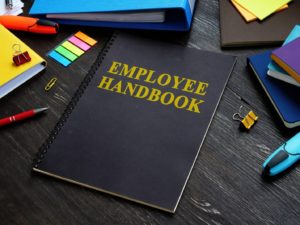Employee handbooks are a crucial tool for company leaders and human resources professionals. While they are essential for company policies and compliance, there is much more to employee handbooks than many people realize. Organizations can use handbooks to relay company visions and culture. They provide a place to go to for guidance while people are working for the business. They are vital communication tools that save managers and human resources personnel time. Documenting rules and policies means that company leaders do not have to explain them to new hires. For more information about the importance of a company employee handbook, consider contacting a knowledgeable attorney at Harrison Law, PLLC, at (480) 320-2310.
What Is the Purpose of an Employee Handbook?
Businesses use employee handbooks to communicate their expectations and keep their policies and procedures consistent. The manuals ensure that everyone within the organization is on the same page and can understand the goals of the business. A well-written manual also reduces the time required for new team members to understand their roles. They can refer to the manual to determine what the employer expects from them. The handbook can convey anything from office functions to how the business will celebrate good performance. The overall purpose of the employee handbook can also be to:
- Defend against unemployment claims and lawsuits
- Set employee and management expectations
- Ensure compliance with state and federal laws
- Introduce company benefits
- Ensure that employers treat employees consistently
Defend Against Unemployment Claims and Lawsuits
Unfortunately, employees sometimes sue their employers. If a lawsuit or claim arises, an employee handbook that is up to date with the company’s policies is one of the most valuable documents. Company leaders can forward the manual to their lawyer as they are preparing to defend the case. The manual can establish compliance with employment laws. A well-drafted handbook will also show that the business exercised reasonable care for all its employees. Handbooks can protect a wide range of issues, including:
- Team member break violations
- Compensation disputes
- Sexual harassment and discrimination
- Company termination policies
The business can present a well-written handbook that addresses all policies and procedures. In addition, the company should be able to provide a copy of the acknowledgment that the team member signed. Organizations can also use these manuals to address issues like favoritism and harassment. They can provide the process for reporting information or violations and how those reports will be managed within the company. The handbook creates a benchmark for company policies and team member expectations.
Set Employee and Management Expectations
The handbook should summarize every policy, procedure, and employment expectation. All staff must have a clear understanding of their roles and responsibilities. Failing to offer team expectations could lead to confusion or non-compliance with policies. The statements must be easy to read and comprehend. Employers need to set the bar for employee and management expectations. All staff from upper management down must understand what the organization expects from them. The handbook can include the company’s policies on appropriate work attire, business hours, and cell phone use at work.
Ensure Compliance With State and Federal Laws
Organizations should consider factors outside the company, specifically state and federal laws and regulations. Employee manuals should provide vital information to show compliance with these laws, including:
- The company mission statement
- The at-will employment statement
- A contractual disclaimer
- Conflict of interest statements
- An equal employment opportunity statement
- Anti-discrimination policies
- Background information on the company
- Standards of conduct
- Workplace safety and security
- Leave policies
Introduce Company Benefits
Employee handbooks should also provide a section with information about the benefits and perks provided by the company. Any health insurance plans, paid time off, and vacation policies should be included. This is also the place to provide information about 401(k) plans, paid parental leave policies, and benefit eligibility requirements. Showcasing a robust benefits package can help employers attract and retain quality talent.
Ensure That Employers Treat Employees Consistently
Companies can prevent retaliation by treating employees consistently. They can also justify some inconsistent treatment in the handbook. The handbook can address rules and consequences for failing to follow company regulations. Organizations that operate on unwritten policies risk having employees believe that their employer is mistreating them. A quality handbook will provide consistency across all departments, giving workers the chance to understand expectations and know what will happen if they fail to meet them.
How Often Should an Employee Handbook Be Updated?
According to the Society for Human Resource Management, employers should do regular handbook reviews. A regular audit will help to determine when company policies need to be updated. Ideally, employers should review their policies annually but no less often than every two years. Another crucial step for organizations is to make sure that all employees sign written acknowledgments after receiving a copy of the updated handbook. The annual handbook review should include:
- Checking to ensure that everything is up to date
- Confirm that no company policy is missing from the handbook
- Identify recent additions
- Review all content to check for spelling and grammatical errors
When employers write employee handbooks, they should use straightforward language and avoid using legal jargon, as it can confuse readers. A seasoned attorney at Harrison Law, PLLC can answer questions about the importance of a company employee handbook.
The Importance of Employee Handbooks
Employee handbooks are an incredible resource for employers and their employees. Taking the time to write handbooks carefully will help businesses ensure that everyone is on the same page. Organizations should provide rules, identify essential objectives, and outline company policies. When employers offer clear expectations, they set their employees up to excel.
According to the Management Library, businesses must consider policies and team member requirements. They must carefully word policies and procedures to ensure that employees will understand them. The manuals should also include a disclaimer that the book’s contents provide guidelines without being a legally binding contract. Business leaders should be aware of local laws and regulations on employment practices to include the most up-to-date information. Because Arizona employment law is constantly changing and evolving, employers must do regular reviews and update their handbooks to ensure compliance with employment laws.
Contact an Experienced Business Law Attorney Today
Every company with employees must have a carefully prepared and updated employee handbook. These manuals outline company policies, expectations, and the organization’s mission. They are the business’s most powerful protection should legal issues arise. One way to determine if handbooks are in compliance and assess risk is to seek guidance from a legal professional. If you have questions about the importance of a company employee handbook, consider contacting an experienced lawyer at Harrison Law, PLLC by calling (480) 320-2310 to schedule a consultation today.
© 2022 Matthew W. Harrison and Harrison Law, PLLC All Rights Reserved
This website and article have been prepared by Harrison Law, PLLC for informational purposes only and does not, and is not intended to, constitute legal or financial advice. The information is not provided in the course of an attorney-client relationship and is not intended to substitute for legal advice from an attorney licensed in your jurisdiction.







